Foreign projects of heavy AUVs and their prospects
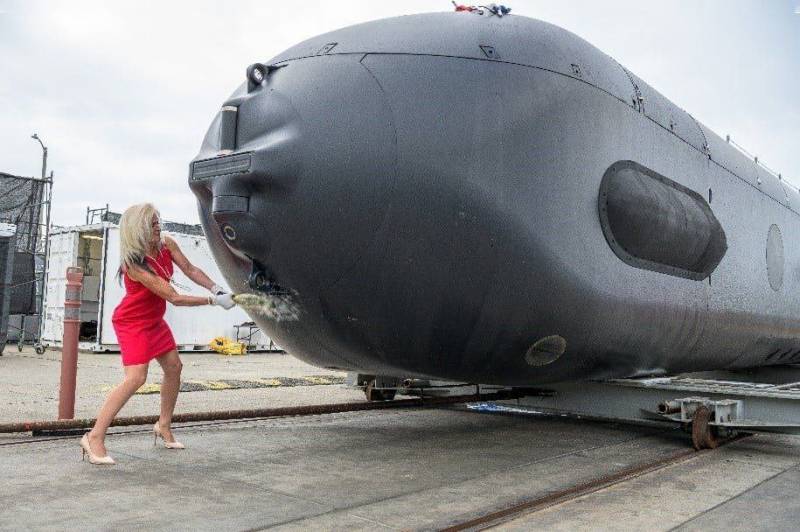
Launching of the Orca lead vehicle for the US Navy, April 2022. Photo by Boeing
In recent years, the direction of autonomous uninhabited underwater vehicles (AUVs) of heavy classes has received the necessary attention and began to actively develop. More and more countries are showing interest in this class of technology and offer their own projects. So, only in the last few months, a number of foreign states have presented their developments of this kind or announced their intention to create them.
In leading positions
Among foreign countries, the leader in the field of heavy AUVs at the moment is the United States. They began to study and work out such concepts a long time ago, which allowed them to break away from competitors. The main modern projects in this area started a few years ago, and by now they have reached the stage of construction and testing of experimental equipment - in contrast to a number of foreign projects, which are still noticeably lagging behind.
At the moment, the main work on the topic of heavy AUVs is being carried out as part of the XLUUV (Extra Large Unmanned Undersea Vehicle) program. It was launched back in 2017, and in 2019 the winner of the competitive stage was chosen. The contract for the development of the project with the Orca code was received by Boeing and Huntington Ingalls Industries.
In May 2022, they completed and launched the first of five planned experimental AUVs. According to known data, it is already being tested and shows its capabilities. In the near future, the development of the group application of such equipment, which is of the greatest interest, will begin. How soon will Orca reach full operation? fleethas not yet been reported.
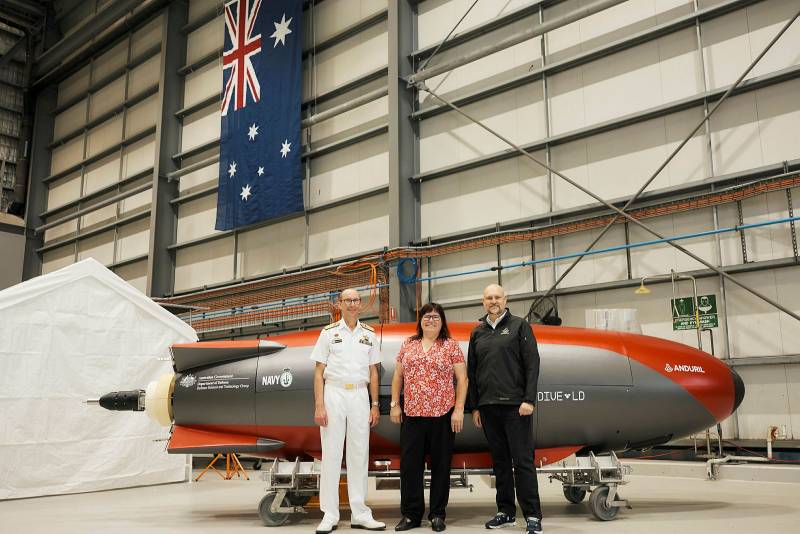
Dive-LD product for Australia. Australian Navy photo
The Orka project provides for the construction of an unmanned submarine 26 m long with a displacement of approx. 50 tons. The AUV is equipped with a diesel-electric power plant with full electric propulsion. Maximum speed - 8 knots. The maximum cruising range is 6500 miles (at 3 knots). The AUV has a cargo compartment 10 m long and can take on board up to 8 tons of payload. It is assumed that the XLUUV Orca will be able to carry various scientific equipment, reconnaissance equipment and even weapons.
With American help
The US industry not only fulfills the contracts of its own Navy, but is also looking for foreign customers. So, Australia became interested in American technology. In the spring of 2022, its Navy issued an order to Anduril Industries for the supply of three Dive-LD AUVs with a total cost of approx. $100 million.
According to the terms of the contract, the first device out of three was to be handed over to the customer before the end of the year. The acceptance ceremony, as planned, took place in December. Delivery of the other two is expected within three years from the date of signing the contract. With the help of the received AUVs, the customer plans to conduct a number of different tests and gain the necessary experience. Then they will start developing a new unmanned complex with all the desired capabilities.
The Dive-LD AUV is generally similar to other products of its class. This is a 5,8 m long submarine with a displacement of approx. 2,7 tons. The power plant is made entirely electric: high-capacity batteries and a propeller motor are used. Maximum speed - 7 knots, cruising range - more than 300 miles with an autonomy of 10 days. Compartments are provided for installing a replaceable payload. During past tests, the apparatus was mainly equipped with hydroacoustic means.
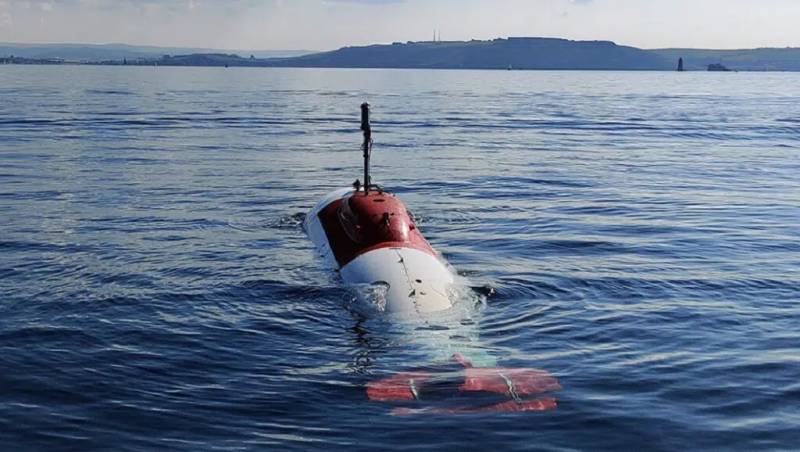
British apparatus S201 on trials. Photo by the British Ministry of Defense
British experience
Like the United States, Great Britain has been dealing with the topic of AUVs for a long time and has already brought its projects to the testing stage. However, her experimental equipment does not have high performance and is still far from real service in the Royal Navy. At the moment, we are talking about working out ideas and gaining experience for subsequent projects.
At the end of the tenth years, the British Ministry of Defense organizations and a number of commercial contractors developed their own version of the AUV under the designation XLUUV. Subsequently, an experimental apparatus was built, known under the tail number S201. In 2020-21 sea trials began, which are still ongoing. After checking the main characteristics of the underwater platform, the issues of using payloads are being worked out.
The British product S201 is made in the form of a submarine with a length of approx. 9 m with a displacement of 9 tons. The resemblance to full-fledged submarines is given by the protruding "cutting house" with some devices. Electrical systems allow the AUV to reach speeds of up to 12 knots; autonomy is limited to 48 hours. Inside the case and on its outer surface there are several places for installing the necessary equipment.
Chinese secrets
It is known that China has long been engaged in the topic of AUVs and is developing vehicles of various classes, including heavy ones. However, until recently, detailed information about these projects was not available. Only in February 2023 did the first official information appear. At the NAVDEX 2023 exhibition in the UAE, the Chinese shipbuilding corporation CSSC showed for the first time an image of a heavy AUV, designated CSSC-705.

The stand of the CSSC corporation at the NAVDEX 2023 exhibition. A promising AUV is shown in the form of graphics. Photo Navalnews.com
Promotional materials show a traditional unmanned submarine. Dimensions and displacement are unknown. Information about energy systems is also missing. At the same time, the AUV has several interesting features. So, on top of it there is a lifting antenna for equipment. The top of the hull can also accommodate a payload bay; similar volumes are viewed on the sides. In the bow there are some covers or plugs. Target equipment or, as was assumed abroad, torpedo tubes can be hidden under them.
Judging by an open demonstration at a foreign exhibition, the CSSC-705 project is not directly related to the military sphere and / or is not the newest development. At the same time, it can be expected that in the interests of the PLA Navy, more advanced AUVs with the appropriate characteristics have already been created and are being tested. When they will be shown to the public is a big question.
New members
The topic of AUV attracts attention, as a result of which projects of this kind appear in new countries. So, only in recent months, several foreign countries have announced or presented new programs for the development of underwater vehicles. It is curious that some of them had not previously engaged in such a technique.
Last year, the structures of the Indian Ministry of Defense for the first time showed their developments on the topic of AUVs. It was reported about the development and imminent construction of a multi-purpose apparatus of large size and displacement. They also showed the layout. In April 2023, it became known that the department was going to complete the current work and bring the program to mass production of equipment. According to existing estimates, the Indian Navy needs 12 heavy AUVs with a shift load.
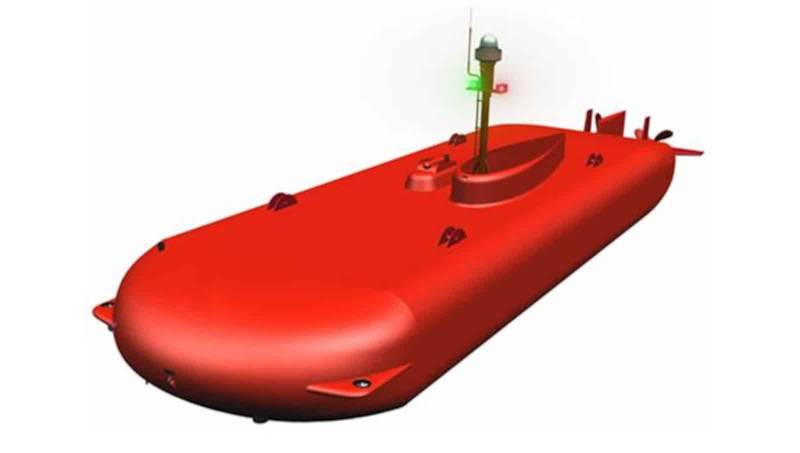
Design image of the MUM product. Graphics TKMS
In February 2023, the German company ThyssenKrupp Marine Systems announced the completion of the design and the imminent start of construction of an experimental MUM (Modifiable Underwater Mothership) AUV. This piece will be approx. 25 m with a large relative width. The case of such proportions will allow you to place more payload, incl. in standard containers. While we are talking about civilian purposes, but the modular architecture will also provide military applications.
In May, at the UDT 2023 exhibition, the Israeli company IAI presented a mock-up of the BlueWhale device. Product length approx. 11 m with a displacement of 5,5 tons is intended for long-term operation at a distance from bases using various target equipment. The AUV is equipped with hydroacoustic, optoelectronic and radar reconnaissance, due to which it will be possible to improve situational awareness and increase reconnaissance potential.
Just a few days ago, at the MADEX 2023 exhibition, the South Korean company Hanwha Ocean demonstrated its vision of the AUV. She developed a multi-purpose apparatus with a length of 23 m and a displacement of 60 tons. Compartments for target equipment are provided, incl. long onboard volumes for hydroacoustic systems. In addition, two torpedo tubes are placed in the nose. Such an AUV can become one of the first samples of its class with full-fledged weapons. However, while the project from Hanwha Ocean is in its early stages, it is still far from construction and testing.
General interest
Thus, the direction of heavy autonomous uninhabited underwater vehicles continues to develop at a good pace. New developments in this area are regularly demonstrated, as well as real samples are built and put to the test. So far, we are talking only about experimental equipment, but over the next few years, mass production is expected to start.
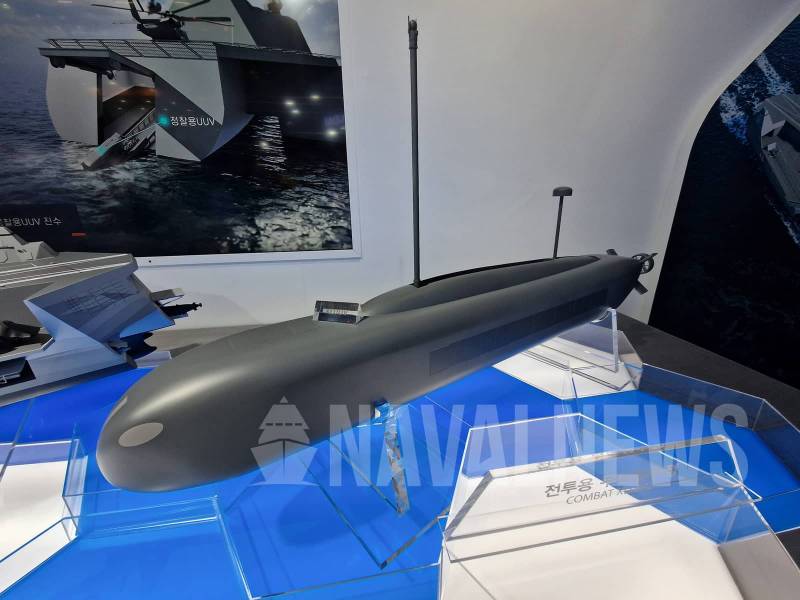
Combat AUV layout from Hanwha Ocean. Photo Navalnews.com
It is curious that by now the development of AUVs has ceased to be the prerogative of exclusively leading countries with developed submarine shipbuilding. New participants without much experience in their respective fields try their hand in this area. In addition, some of them even try to introduce fundamentally new solutions that are not available in the projects of world leaders.
Interest in AUVs is generally understandable. Such equipment, depending on the equipment and configuration, is capable of solving a wide range of tasks related to patrolling, searching for various objects and using weapons. At the same time, despite the need for a number of complex technologies and objective limitations, it is much simpler and cheaper than full-fledged submarines.
As a result, heavy AUVs can be considered as an addition to traditional submarine forces, or even as a replacement for them. Their place in the fleet depends on the needs of specific navies and the capabilities of the industry that supports them. All this provides ample opportunities in the context of military construction and naturally attracts the attention of both the navies of different countries and technology developers.
It is obvious that the development of heavy AUVs will continue. New samples with certain features and advantages will appear regularly. In addition, as the direction develops and new projects appear, the number of potential and real customers of such equipment will increase, which will become an additional incentive for the industry. And already now the world leaders of the direction are being determined, as well as the future commercial market is being formed.
Information